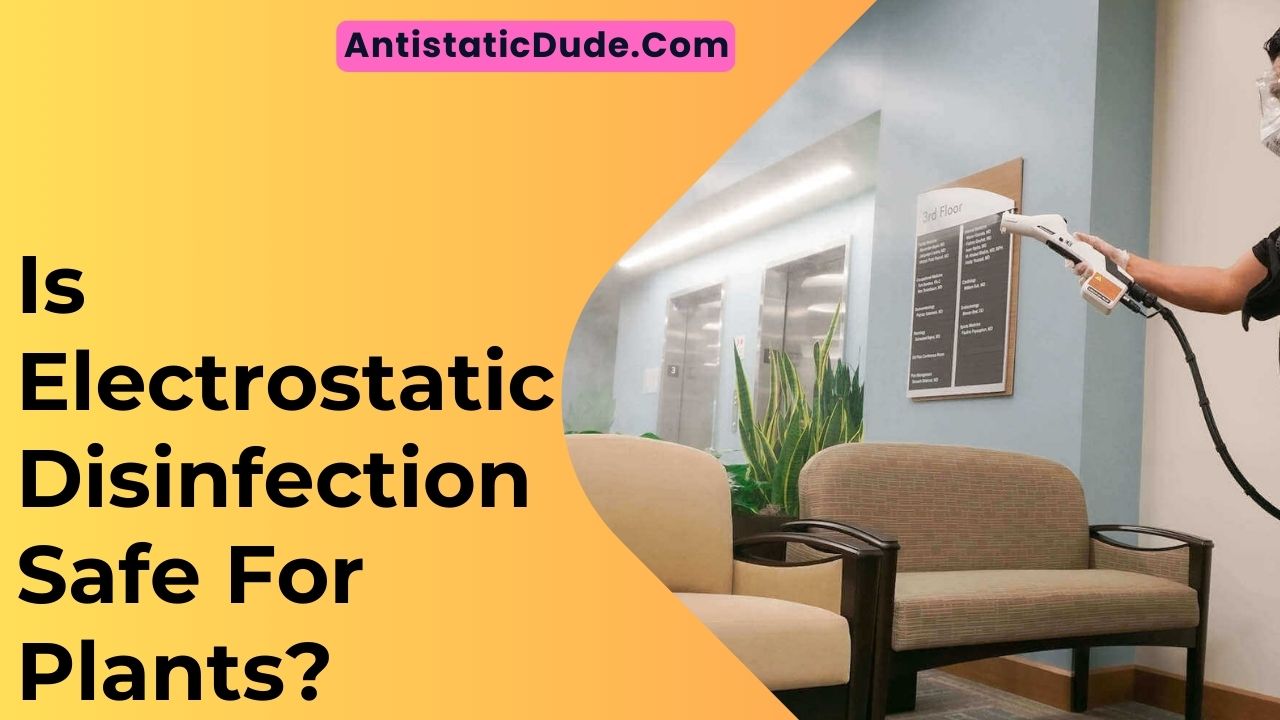As you navigate the realm of plant care, imagine your plants as delicate dancers gracefully swaying in the wind.
But, have you considered the impact of electrostatic disinfection on these green companions?
Before you spray away, ponder this: Is electrostatic disinfection truly safe for your beloved plants, or could there be hidden dangers lurking amidst the mist?

Potential Risks of Electrostatic Disinfection on Plants
When using electrostatic disinfection on plants, you may wonder about the potential risks involved. One primary concern is the possibility of chemical damage to the plant tissues. The chemicals used in the disinfection process could potentially be harmful to the plants if not applied correctly. Overexposure to certain disinfectants may lead to leaf burn, discoloration, or even plant death. It’s crucial to follow the recommended guidelines for dilution and application to minimize these risks.
Another risk to consider is the impact on beneficial microorganisms in the soil. Electrostatic disinfection could potentially disrupt the balance of the soil microbiome, which is essential for the overall health of the plants. Disinfectants may not only target harmful pathogens but also beneficial bacteria and fungi, affecting the plant’s ability to absorb nutrients and water efficiently.
Furthermore, there’s a risk of residue buildup on plant surfaces, which could potentially harm the plant over time. It’s essential to monitor the frequency of disinfection to prevent excessive residue accumulation and ensure the long-term health of your plants.
Impact of Electrostatic Disinfection on Plant Health
Considering the potential risks highlighted in the previous subtopic, it’s essential to understand how electrostatic disinfection impacts the overall health of plants.
Electrostatic disinfection can have both positive and negative effects on plant health. On one hand, if not properly executed, the charged particles from the disinfectant solution may settle on plant surfaces, potentially causing damage. These particles can obstruct the plant’s ability to photosynthesize, leading to wilting or discoloration. Additionally, some disinfectants may contain chemicals harmful to plant life if absorbed through the leaves or roots.
However, when used correctly and at safe distances, electrostatic disinfection can effectively target pathogens while minimizing direct contact with plant surfaces. This method can help prevent the spread of diseases without causing harm to the plants themselves. It’s crucial to follow proper guidelines and precautions to ensure that electrostatic disinfection remains a safe and effective method for plant health maintenance.
Understanding Plant Reactions to Electrostatic Disinfection
To comprehend how plants react to electrostatic disinfection, it’s vital to observe their responses to the charged particles and disinfectant solutions. When considering plant reactions to this cleaning method, keep the following points in mind:
- Electrostatic Attraction: The charged particles in electrostatic disinfection may be attracted to the plant’s surface, affecting how the solution disperses.
- Absorption Potential: Plants vary in their ability to absorb disinfectant solutions, potentially impacting their overall health.
- Leaf Sensitivity: Different plant species and varieties may react uniquely to the chemicals in the disinfectant, affecting their leaves differently.
- Root System Impact: The disinfectant solution may seep into the soil, potentially affecting the plant’s root system and nutrient uptake.
- Long-Term Effects: Observing plants over time after electrostatic disinfection can provide insights into any lasting impacts on growth and development.
Understanding these aspects can help you gauge how electrostatic disinfection may influence your plants and how to best protect them during the cleaning process.
Tips for Safeguarding Plants During Electrostatic Disinfection
Ensure plant protection during electrostatic disinfection by implementing these strategies. Before starting the electrostatic disinfection process, make sure to cover your plants with plastic sheets or tarps to shield them from the disinfectant spray. It’s essential to carefully secure the coverings to prevent any leaks or seepage onto the plants. Additionally, consider relocating sensitive plants to a different room or area where they won’t be exposed to the disinfectant mist.
Another tip is to water your plants before disinfection. Moist soil can help minimize the absorption of disinfectant chemicals through the roots. After the disinfection process, thoroughly rinse the plants with water to remove any residue that may have settled on their leaves. This step is crucial to prevent potential damage to the plants over time.
Lastly, if you notice any signs of plant distress after electrostatic disinfection, such as wilting, yellowing, or leaf spots, consult with a plant care professional for guidance on how to mitigate any negative effects and promote plant recovery. Taking these precautions will help safeguard your plants during the electrostatic disinfection process.
Best Practices for Plant Safety in Disinfection Processes

Safeguarding your plants during disinfection processes involves implementing best practices to ensure their safety and well-being. When disinfecting areas near plants, it’s important to take precautions to protect them from any potential harm. Here are some best practices to follow:
- Cover plants: Shield your plants with plastic or cloth covers before starting the disinfection process to prevent direct contact with the disinfectant.
- Choose plant-safe disinfectants: Opt for disinfectants that are specifically labeled as safe for plants to avoid any negative effects on their health.
- Follow instructions carefully: Always read and adhere to the instructions provided by the disinfectant manufacturer to use the product safely around plants.
- Time disinfection carefully: Schedule disinfection processes during times when plants are less active or can be moved to a safe area temporarily.
- Monitor plant health: Keep an eye on your plants after disinfection to ensure they show no signs of distress or damage, and take immediate action if needed.
Frequently Asked Questions
Can Electrostatic Disinfection Harm the Soil Surrounding Plants?
When using electrostatic disinfection near plants, ensure proper precautions to protect the soil. The process can potentially harm the soil surrounding plants if not executed carefully. Take care to shield the area during disinfection.
Are Certain Types of Plants More Susceptible to Damage From Electrostatic Disinfection?
Some plants, like delicate flowers or young seedlings, may be more susceptible to damage from electrostatic disinfection. It’s important to research specific plant sensitivities and adjust disinfection methods accordingly to protect them.
How Long Should Plants Be Kept Away From Treated Areas After Electrostatic Disinfection?
After electrostatic disinfection, keep plants away from treated areas for at least 30 minutes. This allows the disinfectant to settle and reduces potential exposure. Ensure proper ventilation before reintroducing plants to the space for their safety and well-being.
Is There a Risk of Chemical Residue From Disinfectants Affecting Plant Growth?
Chemical residue from disinfectants may pose a risk to plant growth. Ensure proper ventilation and time for any residues to dissipate before reintroducing plants. Prioritize plant health by being mindful of potential impacts and taking necessary precautions.
Can Electrostatic Disinfection Impact the Beneficial Microbes in the Soil That Plants Rely On?
When using electrostatic disinfection, consider if it affects the beneficial soil microbes crucial for plant growth. Research and consult experts to ensure your disinfection methods don’t harm these essential components supporting your plants.
Conclusion
Overall, it’s important to be cautious when using electrostatic disinfection around plants. While it can be an effective method for killing germs and viruses, there are potential risks to plant health.
By understanding how plants react to the process and taking necessary precautions, such as covering or moving plants during disinfection, you can help safeguard your greenery.
Remember to prioritize plant safety and follow best practices to ensure a healthy environment for both your plants and yourself.


Leave a Reply